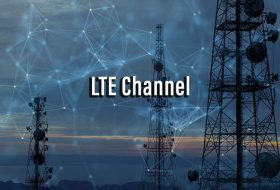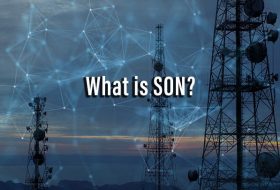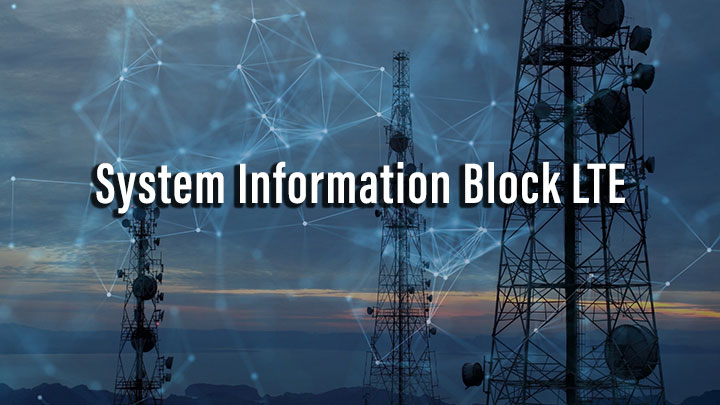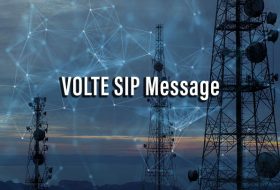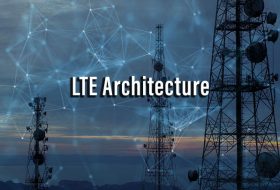System Information Block
System information is divided into the MasterInformationBlock (MIB) and a number of SystemInformationBlocks (SIBs).
System Information Blocks in LTE, SIBs carry relevant information for the UE, which helps UE to access a cell, perform cell re-selection, information related to INTRA-frequency, INTER-frequency, and INTER-RAT cell selections.
In LTE there are 13 types of SIBs. Each SIB has its own job to do, which means, they are meant to carry information which are related to performing their assigned job.
All SIBs are transmitted on BCCH->DL-SCH->PDSCH.
In LTE, for a UE to access the eNB, at the most minimum 2 SIBs are required (SIB1 and SIB2).
Information regarding SIB2-SIB13 are carried in SI messages and are included in schedulingInfoList which is part of SIB1.
Scheduling of SIBs:
· SIB1 uses a fixed schedule with a periodicity of 80 ms and repetitions made within 80 ms.
· The first transmission of SIB1 is scheduled in subframe #5 of radio frames for which the SFN mod 8 = 0, and
· Repetitions are scheduled in subframe #5 of all other radio frames for which SFN mod 2 = 0.
· Scheduling of other SIB’s i.e. SIB-2 to SIB-9 is defined by si-Periodicity and si-WindowLength. Both these IEs are explained below. For the rest of the SIBs, Paging is received by UE in RRC_IDLE or RRC_CONNECTED mode for notification of an in-coming SI message.
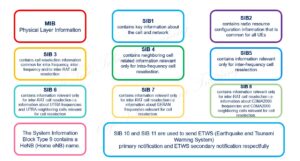
Scenarios where UE acquire SIBs
UE will initiate the SIB acquisition procedure in any of the following criteria’s:
· UE is powered on (selecting a cell)
· Cell re-selection
· After HO completion
· After entering E-UTRAN from another RAT
· coming out of OUT OF COVERAGE situation
· receiving a notification that SYSTEM INFORMATION has changed
· receiving an indication about the presence of ETWS (Primary/Secondary), CMAS notification
· receiving a request from CDMA 2000 upper layers
· exceeding the maximum validity duration of SIBs
HOW and WHEN UE start acquiring SIBs (other than SIB1):
There are two IE’s which help the UE to calculate when to read SI messages.
They are:
a. schedulingInfoList
b. si-WindowLengthd schedulingInfoList informs the UE regarding the presence of SIB type; other than SIB1. It carriers two more parameters:
i. si_Periodicity
ii. sib_MappingInfo
· si_Periodicity tells about the period in terms of radio frames which helps the UE to read the required SIB. The value of this parameter is used for calculating the Radio frame where SI will be received.
· sib_MappingInfo carries the type of SIBs mapped si-WindowLength specifies that a SIB should be transmitted somewhere within the specified window length. Value is in ms. This window starts at the starting sub-frame of the mentioned si_periodicity. SIBs can be received in any of the sub-frame as mentioned in the WindowLength.
SIB1 in LTE
The first SIB: SIB1
SIB1 contents assist the UE when it is evaluating cell access and also defines the scheduling of other system information.
Signalling radio bearer: N/A
RLC-Mode: TM
Logical channel: BCCH
Direction: E-UTRAN to UE
• SIB1 is broadcasted at every 80 ms and is repeated are mabe within 80ms
• The first transmission is made at SubFrame 5 for which SFN mod 8 = 0
• Repetitions are scheduled in SubFRame 5 for which SFN mod 2 = 0
Important contents of System Information Block Type-1
Field Descriptions:
| Field | Description |
| PLMN-Identity | Consists of MCC and MNC. The first listed one is the Primary PLMN |
| p-Max | Value applicable for the cell. If absent the UE applies the maximum power according to the UE capability. If eNB configures the value more than the value supported by the UE then UE will set the max value aupported by the UE capability. Example UE Catagory 3 supports max 23 db |
| cellReservedForOperatorUse | As defined by operator (Reserved/Not_reserved) |
| trackingAreaCode | TAC which is common to the PLMN Identities |
| cellIdentity | Identifies a cell within the PLMN |
| cellBarred | If Barred then UE is not allowed to camp on the cell |
| intraFreqReselection | If enabled, UE will be able to perform Cell-reselection to INTRA-frequency cells |
| q_RxLevMin | Minimum required RX level in the cell |
| q_RxLevMinOffset | Actual value Qrxlevminoffset = IE value * 2 [dB]. only applied when a cell is evaluated for cell selection as a result of a periodic search for a higher priority PLMN while camped normally in a VPLMN [5]. During this periodic search for higher priority PLMN the UE may check the S criteria of a cell using parameter values stored from a different cell of this higher priority PLMN. Affects the minimum required Rx level in the cell. |
| freqBandIndicator | indicates the E-UTRA operating band |
| schedulingInfoList | information regarding the presence of SIB type; other than SIB1 |
| si_Periodicity | Periodicity of the SI-message in radio frames (SI will be transmitted within the specified radio frame) |
| sib_MappingInfo | carries the List of the SIBs mapped. SIB2 is always present in the first element of schedulingInfoList |
| si_WindowLength | specifies that a SIB should be transmitted somewhere within the specified window length. Value is in ms. This window starts at the starting sub-frame of the mentioned si_periodicity. SIBs can be received in any of the sub-frame as mentioned in the WindowLength. |
| systemInfoValueTag | indicates if a change has occurred in the SI messages. UEs may use systemInfoValueTag, e.g. upon return from out of coverage, to verify if the previously stored SI messages are still valid. Additionally, the UE considers stored system information to be invalid after 3 hours from the moment it was successfully confirmed as valid, unless specified otherwise. Common for all SIBs other than MIB, SIB1, SIB10, SIB11 and SIB12. |
SIB2 in LTE
SIB-2: an IMPORTANT SIB
• The IE SystemInformationBlockType2 contains radio resource configuration information that is common for
all UEs.
• It carries Common and shared channel configuration, RACH related configuration, Timers, UL Power
controls.
• Without this SIB UE cannot initiate ATTACH procedure.
• SIB2 is not specifically included in the scheduling information in SIB1 but it is always mapped to the SI
the message that corresponds to the first entry in the list of SI messages in schedulingInfoList in SIB1
Signalling radio bearer: N/A
RLC-Mode: TM
Logical channel: BCCH
Direction: E-UTRAN to UE
Important contents of System Information Block Type-2
Field Descriptions:
| Field | Description |
| ac-BarringInfo | Access Class Barring configuration |
| radioResourceConfig | used to specify common radio resource configurations in the system information and in the mobility control information |
| numberOfRA_Preambles | Number of non-dedicated random access preambles |
| preamblesGroupAConfig_exist | Provides the configuration for preamble grouping. If the field is not signalled, the size of the random access preambles group A is equal to numberOfRA Preambles |
| powerRampingParameters | |
| powerRampingStep | Power ramping factor |
| preambleInitialReceivedTargetPower | Initial preamble power |
| ra_SupervisionInfo | |
| preambleTransMax | Maximum number of preamble transmission |
| ra_ResponseWindowSize | Duration of the RA response window. Value in subframes. Value sf2 corresponds to 2 subframes |
| mac_ContentionResolutionTimer | Timer for contention resolution. Value in subframes. Value sf8 corresponds to 8 subframes |
| maxHARQ_Msg3Tx 4 | Maximum number of Msg3 HARQ transmissions, used for contention based random access |
| bcch_Config | |
| modificationPeriodCoeff | Actual modification period, expressed in number of radio frames= modificationPeriodCoeff * defaultPagingCycle. n2 corresponds to value 2 |
| pcch_Config |
| defaultPagingCycle | Default paging cycle, used to derive ‘T’. Value rf32 corresponds to 32 radio frames |
| nB | is used as one of parameters to derive the Paging Frame and Paging Occasion |
| prach_Config | used to specify the PRACH configuration in the system information and in the mobility control information |
| rootSequenceIndex | |
| prach_ConfigIndex | mentions the: Preamble format: 0-4 (For frame structure 1 preamble format is 0-3 and for frame structure 2 it is 0-4), SFN: whether it will be EVEN no. frmae OR any frame, subframe number: carrier the subframe no. within the SFN |
| highSpeedFlag | TRUE corresponds to Restricted set and FALSE to Unrestricted set |
| zeroCorrelationZoneConfig | used for Preamble generation |
| pdsch_Config | used to specify the common and the UE specific PDSCH configuration |
| pusch_Config | used to specify the common PUSCH configuration and the reference signal configuration for PUSCH and PUCCH |
| pucch_Config | used to specify the common and the UE specific PUCCH configuration |
| soundingRS_UL_Config | used to specify the uplink Sounding RS configuration |
| uplinkPowerControl | used to specify parameters for uplink power control in the system information and in the dedicated signalling |
| ue_TimersAndConstants | Timer values |
| freqInfo | UL carrier frequency and bandwidth |
| timeAlignmentTimerCommon | used to control how long the UE is considered uplink time aligned. Value in subframes |
SIB3 in LTE
SIB3: Cell-reselection parameters for INTRA-Frequency, INTER-Frequency and Inter-RAT
• contains Cell re-selection rmation common for intra-frequency, inter-frequency and inter-RAT cell reselection (i.e. applicable for more than one type of cell re-selection but not necessarily all)
• intra-frequency cell re-selection rmation other than neighbouring cell related
Signalling radio bearer: N/A
RLC-Mode: TM
Logical channel: BCCH
Direction: E-UTRAN to UE
Important contents of System Information Block Type-3
Field Descriptions:
| Field | Description |
| cellReselectionInfoCommon | Cell re-selection information common for cells |
| q_Hyst | This specifies the hysteresis value for cell re-selection ranking criteria. The specified value is added to the serving cell RSRP measurement. |
| speedStateReselectionPars | Speed dependent reselection parameters. If this field is absent then mobility State Parameters is not present. If q_hystSF is present then it is added to q_hyst. Carrier (-) value so as to reduce the ranking of the serving cell and allows cellreselection to occur easily. |
| cellReselectionServingFreqInfo | Information for Cell re-selection to inter-frequency and inter-RAT cells |
| s_NonIntraSearch | #used to trigger Interfrequency and IRATfrequency measurements for cell reselection when: – TARGET Interfreq. has lower or equal priority – IRAT freq. has a lower priority # specifies the Srxlev threshold (in dB) for E-UTRAN inter-frequency and inter-RAT measurements. #If the field s-NonIntraSearchP is present, the UE applies the value of s NonIntraSearchP. # Otherwise if neither s-NonIntraSearch nor s-NonIntraSearchP is present, the UE applies the (default) value of infinity for SnonIntraSearchP. |
| threshServingLow | This specifies the Srxlev threshold (in dB) below which the serving cell must fall before reselecting towards a lower priority RAT/ frequency. Value in between 0- 31dB. Actual value=signalled value*2 |
| cellReselectionPriority | explains the absolute priority of the concerned serving cell frequency /set of frequencies (GERAN)/ bandclass (CDMA2000), as used by the cell reselection procedure. Corresponds with parameter “priority”. Value is between 0-7 where 0 means: lowest priority. |
| intraFreqCellReselectionInfo | Cell re-selection information common for intra-frequency cells |
| q_RxLevMin | Minimum required RSRP for cell reselection. value -70 – 22 dbm, Actual value=signalled value*2 |
| s_IntraSearch | # used to trigger intrafreq. measurements # specifies the Srxlev threshold (in dB) for intra-frequency measurements. # If the field s-IntraSearchP is present, the UE applies the value of s-IntraSearchP instead. Otherwise if neither 09s-IntraSearch nor s-IntraSearchP is present, the UE applies the (default) value of infinity for SIntraSearchP. |
| presenceAntennaPort1 | is used to09 indicate whether all the neighbouring cells use 09Antenna Port 1. When set to TRUE, the UE may assume that at least two cell-specific antenna ports are used in all neighbouring cells. |
| neighCellConfig | used to provide the information related to MBSFN and TDD UL/DL configuration of neighbour cells. |
| t_ReselectionEUTRA | # specifies the cell reselection timer value # defines time to trigger for cell reselection # The parameter can be set per E-UTRAN frequency e |
| p_Max | # max. allowed UL transmit power for intra-frequency neighbouring E-UTRA cells. If absent the UE applies the maximum power according to the UE capability |
SIB4 in LTE
SIB4: Cell-reselection parameters for Neighbouring INTRA-Frequency
• contains neighbouring cell related rmation relevant only for intra-frequency cell re-selection
• includes cells with specific re-selection parameters as well as blacklisted cells
• All the contents of SIB4 are optional because UE’s can automatically detect and complete neighbour
INTRA_frequency cells
Signalling radio bearer: N/A
RLC-Mode: TM
Logical channel: BCCH
Direction: E-UTRAN to UE
Important contents of System Information Block Type-4
Field Descriptions:
| Field | Description |
| intraFreqNeighCellList[1-16 instances] |
List of intra-frequency neighbouring cells with specific cell re-selection parameters |
| IntraFreqNeighCellInfo | |
| physCellId | Physical CellID of the neighbour cell |
| q-OffsetCell | specifies the offset between the two cells. Value -24 – +24dB |
| intraFreqBlackCellList[1-16 instances] |
List of blacklisted intra-frequency neighbouring cells. These type of cells are not considered for cell re-selection |
| csg_PhysCellIdRange | Set of physical cell identities reserved for CSG cells on the frequency on which this field was received. The received csg-PhysCellIdRange applies if less than 24 hours has elapsed since it was received and it was received in the same primary PLMN. This field is Optional (mandatory for CSG cell) |
SIB5 in LTE
SIB5: Cell-reselection parameters for INTER-Frequency
• contains information relevant only for inter-frequency cell re-selection i.e. information about other E-UTRA
frequencies and inter-frequency neighbouring cells relevant for cell re-selection
• includes cell re-selection parameters common for a frequency as well as cell specific re-selection parameters
Signalling radio bearer: N/A
RLC-Mode: TM
Logical channel: BCCH
Direction: E-UTRAN to UE
Important contents of System Information Block Type-5
Field Descriptions:
| Field | Description |
| InterFreqCarrierFreqInfo | can be specified upto 8 carrier frequencies |
| dl-CarrierFreq | carrier frequency helps the UE to search the cells |
| q-RxLevMin | minimum RSRP value of the inter-frequency cell. Value -70 to -22 dBm. Actual value: signalled value * 2 |
| p-Max | maximum allowed UL transmit power of the cell |
| t-ReselectionEUTRA | defines the time to trigger for cell reselection. Value 0 to 7 sec. |
| t-ReselectionEUTRA-SF | scaling factors for Medium and High mobility |
| threshX-High | # Threshold (in dB) used by UE for cell re-selection to a HIGHER priority # The Srxlev of the candiate cell is greater then threshX_High # Value 0 to 31 dB. Actual value= Signaled value * 2 |
| threshX-Low | # Threshold (in dB) used by UE for cell re-selection to a LOWER priority # Cell re-selection is allowed only when Srxlev of the candiate cell is greater then threshX_Low and RSRP of serving cell is less than the value of ThreshServingLow singalled within SIB3 # Value 0 to 31 dB. Actual value= Signaled value * 2 |
| allowedMeasBandwidth | defined in terms of Resouce blocks associated with a specific channel bandwidth |
| cellReselectionPriority | defines the Abolute priority of the frequency layer |
| neighCellConfig | information regarding the neighbouring cells |
| q-OffsetFreq | defines the RSRP measurement offset, applied to all cells on the specified RF carrier |
| interFreqBlackCellList | the mentioned cells are no considered for cell reselection |
SIB6 in LTE
SIB6: Cell-reselection parameters INTER RAT Frequency
• contains information relevant only for inter-RAT cell re-selection (information about UTRA frequencies and
UTRA neighbouring cells relevant for cell re-selection.
• includes cell re-selection parameters common for a frequency
Signalling radio bearer: N/A
RLC-Mode: TMLogical channel: BCCH
Direction: E-UTRAN to UE
Important contents of System Information Block Type-6
Field Descriptions:
| Field | Description |
| carrierFreqListUTRA_FDD/TDD | Information specified for up to 16 instances of RF carriers for FDD or TDD |
| carrierFreq | carrier frequency helps the UE to seach |
| cellReselectionPriority | defines the absolute priority of the UMTS. Value 0-7, 0 is the lowest priority |
| threshX_High | # Threshold (in dB) used by UE for cell re-selection to a HIGHER priority UMTS frequency # The Srxlev of the candiate cell is greater then threshX_High # Value 0 to 31 dB. Actual value= Signaled value * 2 |
| threshX_Low | # Threshold (in dB) used by UE for cell re-selection to a LOWER priority UMTS frequency # Cell re-selection is allowed only when Srxlev of the candiate cell is greater then threshX_Low and RSR of serving cell is less than the value of ThreshServingLow singalled within SIB3 # Value 0 to 31 dB. Actual value= Signaled value * 2 |
| q_RxLevMin | minimum RSCP requirement for candiate UMTS cell. Value -60 to -13 dB. Actual value= Signaled value * 2 +1 |
| p_Max | Value applicable for the intra-frequency neighbouring E-UTRA cells. If absent the UE applies the maximum power according to the UE capability |
| q_QualMin | # minimum Ec/Io requirement for candiate UMTS cell. Value -24 to 0 dB # applicable for FDD only |
| t_ReselectionUTRA | # defines the time to trigger cell re-selection, # value 0 – 7 seconds |
| t_ReselectionUTRA_SF | # defines the time to trigger cell re-selection # value 0 – 7 seconds # Scaling factors used for Medium and High mobility # Scaling Factors value 0.25, 0.5, 0.75, 1.0. These values decrease the value of T_reselection which allows more rapid cell re-selections |
SIB7 in LTE
SIB7: Cell-reselection parameters INTER RAT Frequency (GERAN)
• contains information relevant only for inter-RAT (GERAN) cell re-selection
Signalling radio bearer: N/A
RLC-Mode: TM
Logical channel: BCCH
Direction: E-UTRAN to UE
Important contents of System Information Block Type-7
Field Descriptions:
| Field | Description |
| t_ReselectionGERAN | Time to trigger for re-selection. Value 0 to 7 sec. |
| carrierFreqsInfoList[0] | carries upto 16 instances of GERAN freq. |
| carrierFreqs | |
| startingARFCN | Start of the ARFCN |
| bandIndicator | dcs1800 or pcs1900 |
| followingARFCNs | ARFCN groups |
| cellReselectionPriority | absolute priority of the GERAN layer. Value 0 to 7, whereas 0 is the lowest priority |
| ncc_Permitted | Network Color Code. Is a bitmap value |
| q_RxLevMin | minimum RSSI value required |
| p_MaxGERAN | maximum allowed UL transmit power |
| threshX_High | # Threshold (in dB) used by UE for cell re-selection to a HIGHER priority frequency # The Srxlev of the candiate cell is greater then threshX_High # Value 0 to 31 dB. Actual value= Signaled value * 2 |
| threshX_Low | # Threshold (in dB) used by UE for cell re-selection to a LOWER priority frequency # Cell re-selection is allowed only when Srxlev of the candiate cell is greater then threshX_Low and RSRP of serving cell is less than the value of ThreshServingLow singalled within SIB3 # Value 0 to 31 dB. Actual value= Signaled value * 2 |
SIB8 in LTE
Information for re-selection to INTER-RAT (CDMA2000)
SIB9 in LTE
SIB9: Home eNB name
• contains a home eNB name (HeNB Name)
• HeNB provie services to Closed Subscriber Groups. The HeNB name helps the user to select the correct CSG
Identity when performing a manual selection
Signalling radio bearer: N/A
RLC-Mode: TM
Logical channel: BCCH
Direction: E-UTRAN to UE
Important contents of System Information Block Type-9
Field Descriptions:
| Field | Description |
| hnb-Name | Carries the name of the home eNB |
SIB10 in LTE
SIB10: ETWS primary notification
• contains an ETWS primary notification
Signalling radio bearer: N/A
RLC-Mode: TM
Logical channel: BCCH
Direction: E-UTRAN to UE
Important contents of System Information Block Type-10
Field Descriptions:
| Field | Description |
| messageIdentifier | Identifies the source and type of ETWS notification (earthquake, tsunami warning, any emergency or test message) |
| serialNumber | Identifies variations of an ETWS notification. -uses various mechanisms to alert the user (display message, play a tone or vibrate, location where the message is applicable, also contains an update number which specifies whether a change is in the message content or not) |
| warningType | # Identifies the warning type of the ETWS primary notification (earthquake, tsunami, etc.) and # provides information on emergency user alert and UE popup |
| warningSecurityInfo | # is optional, only applied when security is applied # Provides security information for the ETWS notification |
SIB11 in LTE
SIB11: ETWS secondary notification
• contains an ETWS secondary notification
Signalling radio bearer: N/A
RLC-Mode: TM
Logical channel: BCCH
Direction: E-UTRAN to UE
Important contents of System Information Block Type-11
Field Descriptions:
| Field | Description |
| messageIdentifier | Identifies the source and type of ETWS notification (earthquake, tsunami warning, any emergency or test message) |
| serialNumber | Identifies variations of an ETWS notification. -uses various mechanisms to alert the user (display message, play a tone or vibrate, location where the message is applicable, also contains an update number which specifies whether a change is in the message content or not) |
| warningMessageSegmentType[last/not last] |
Indicates whether the included ETWS warning message segment is the last segment of the complete segment or not |
| warningMessageSegmentNumber | # allows oedering of the message segments # Segment number of the ETWS warning message segment contained in the SIB. A segment number of zero corresponds to the first segment, one corresponds to the second segment, and so ons |
| warningMessageSegment | carries actual segment of the message |
| dataCodingScheme | Identifies the alphabet/coding and the language applied variations of an ETWS notification |
SIB12 in LTE
SIB12: CMAS notification
• contains a CMAS notification
• CMAS notifications carry high emerygency situations and is defined for three catagories:
-Presiential Alerts (President of a geographical location can send alerts)
-Threat Alerts (Tornado/Hurricane alerts)
-AMBER Alerts (Child abduction, endangered situation)
• introduced in Release9
Signalling radio bearer: N/A
RLC-Mode: TMLogical channel: BCCH
Direction: E-UTRAN to UE
Important contents of System Information Block Type-12
Field Descriptions:
| Field | Description |
| messageIdentifier | Identifies the source and type of CMAS notification |
| serialNumber | Identifies variations of a CMAS notification |
| warningMessageSegmentType | Indicates whether the included CMAS warning message segment is the last segment or not |
| warningMessageSegmentNumber | Segment number of the CMAS warning message segment contained in the SIB. A segment number of zero corresponds to the first segment, one corresponds to the second segment, and so on |
| warningMessageSegment | Carries a segment of the Warning Message |
| dataCodingScheme | Identifies the alphabet/coding and the language applied variations of a CMAS notification |
SIB13 in LTE
SIB13: MBMS control information
• contains the rmation required to acquire the MBMS control rmation associated with one or more
MBSFN areas
• introduced in Release9
Signalling radio bearer: N/A
RLC-Mode: TM
Logical channel: BCCH
Direction: E-UTRAN to UE
Important contents of System Information Block Type-13
mbsfn-AreaInfoList
You Might Also Like
